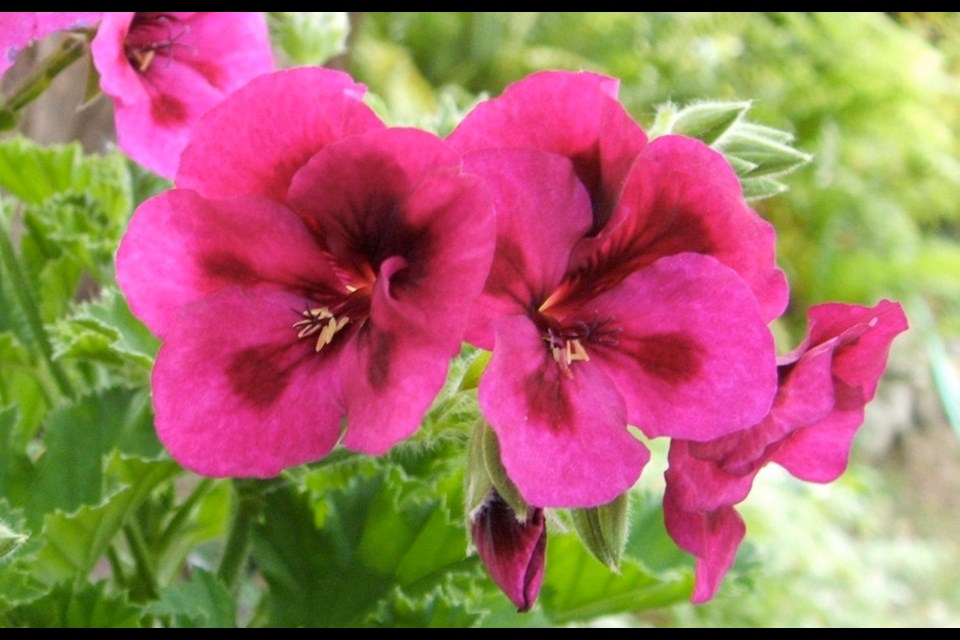Dear Helen: How do I winter my potted Martha Washington geranium plant? I’m also wondering whether this kind of geranium and zonal geraniums share the same growing condition requirements.
F.G.
Both zonal and Martha Washington geraniums are frost-tender Pelargoniums, but they are very different in their preferred growing conditions. Zonals do best in warmth and soil conditions on the dry side. Martha Washingtons (Pelargonium domesticum, Regal geranium) need cool temperatures to thrive and bloom well.
In the spring, especially around Mother’s Day, Martha Washington geraniums are popular gift plants. They are impressive — compact, thickly bushy plants bearing ornamental leaves with finely fringed edges and clusters of large, showy flowers beautifully veined and splashed in vividly contrasting colours.
The bloom period can be long if the plant is placed in a cool, lightly shaded spot outdoors as the weather warms. Martha Washingtons often take a break from flowering in the high heat of summer — just as the zonals are hitting their peak of bloom.
Martha Washingtons also winter best in cool temperatures, ideally in a frost-free location with only enough water to keep them alive. Cool winter temperatures in the 10 to 15 C range, together with bright light and a dryish soil, contribute to successful wintering and help at the same time to set these lovely plants up for really good flowering from late spring onward.
Dear Helen: We grew pumpkins, successfully, for the first time this summer, and we’ve begun using them. How are the seeds processed for eating? I presume they are roasted in the oven. How are they prepared? Do you drizzle them with oil first?
L.P.
I don’t use oil on pumpkin seeds for roasting, though most directions you’ll come across do recommend it. I prefer the crisp, clean flavour and texture of the seeds roasted with just a dusting of freshly ground salt.
Specifically, I use a sea salt and kelp mixture that comes in a refillable grinder. It’s a product from Gathering Place on Cortes Island. I use the blend on all my savoury foods. It’s a delicious way to increase one’s daily nutrient intake, since kelp is a source of many beneficial minerals. For that reason I use kelp meal in the garden as well, as the potassium and mineral component of the fertilizer blend I make.
Visit gatheringplacetrading.com to find the closest retailer carrying the company’s products.
The seed gathering and roasting is quick and easy. I simply extricate the seeds from the fibrous centre of a pumpkin, spread them on a baking sheet, dust them lightly with the sea salt and kelp, and roast at around 275 F until the seeds have attained a tasty crispness. This does not usually take long. Around 15 or 20 minutes into the roasting, I use a spatula to loosen the seeds up. That’s when I begin taste-testing.
Dear Helen: I’ve moved my potted zonal geraniums into shelter and am about to take cuttings from them. I also have a wax begonia and a coleus to take cuttings from. Should I place a plastic cover over the potted cuttings to maintain high levels of humidity around them while they are rooting?
A.H.
Plastic “humidity tents” over, but not touching, cuttings while they root are generally helpful, but don’t use one over cuttings of zonal geranium (Pelargonium hortorum, P. zonale), which are sensitive to damp conditions. High humidity levels foster rotting of the cuttings at the soil line. It’s a condition called “black rot.”
Zonal geraniums root very easily in warmth, bright light, and a porous, that is free-draining planting mix kept just modestly moist.
Coleus and was begonia cuttings both benefit from the extra humidity inside a plastic covering such as a clear plastic bag fitted over the pot. Cut ventilation slits or holes in the plastic, and remove the cover daily to expose the cuttings fully to fresh air before turning the cover inside out and replacing it.
Remove the lower leaves from the cuttings, which should be around seven cm long with the base cut positioned immediately beneath a leaf node. Reduce the area of large coleus leaves by making clean cuts with sharp scissors across the top and sides of the leaves. This will reduce evaporation stress to the cutting and help facilitate rooting.
New growth appearing on a cutting is a sign that it has rooted. At that point, the humidity tent can be removed.



